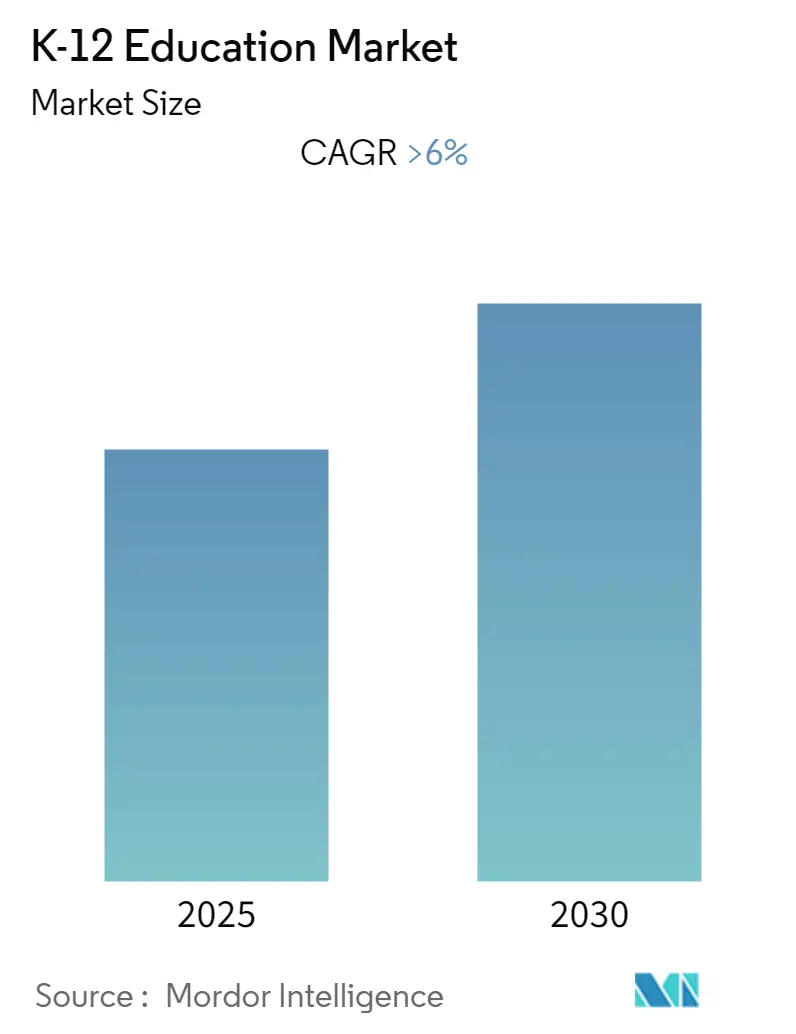
| Study Period | 2019 - 2030 |
| Base Year For Estimation | 2024 |
| Forecast Data Period | 2025 - 2030 |
| CAGR | 6.00 % |
| Fastest Growing Market | Asia Pacific |
| Largest Market | Asia Pacific |
| Market Concentration | Low |
Major Players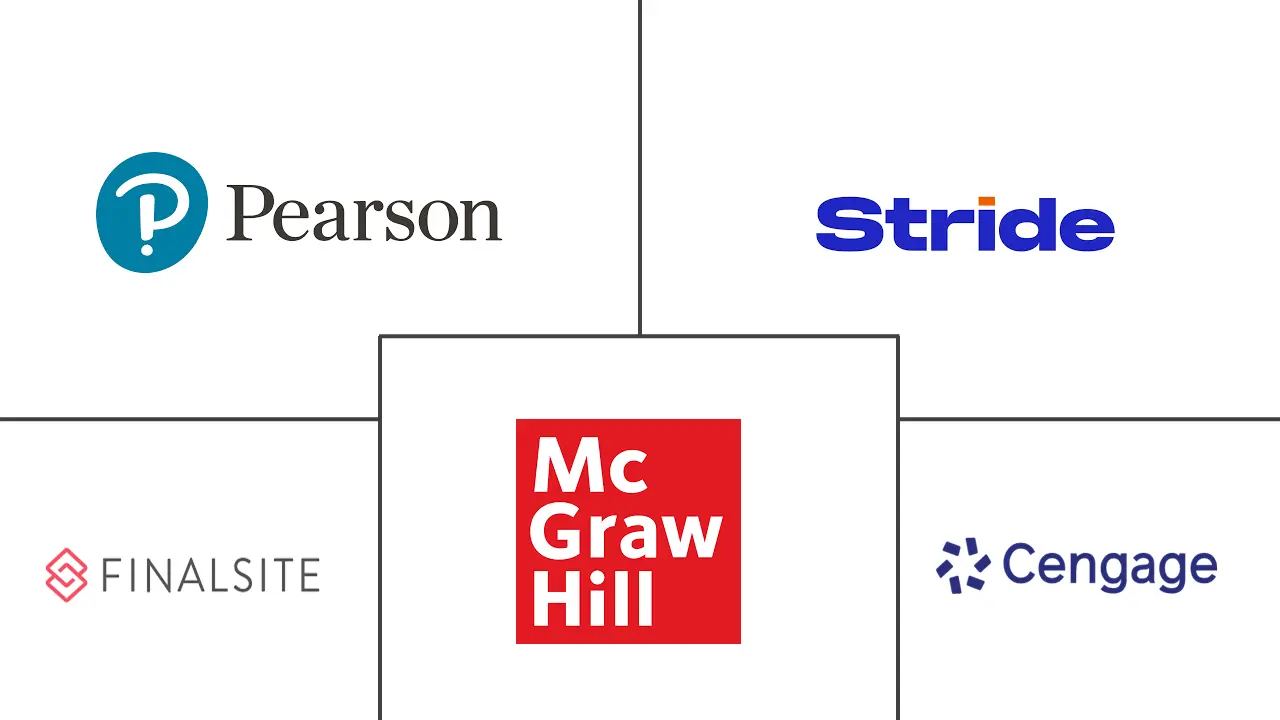
*Disclaimer: Major Players sorted in no particular order |
K-12 Education Market Analysis
The K-12 Education Market is expected to register a CAGR of greater than 6% during the forecast period.
The K-12 education sector is currently experiencing a profound transformation, shaped by key education market trends such as the increasing digitalization of learning environments, the growing emphasis on STEM education, and the global push towards standardized curricula. The adoption of digital tools and platforms, collectively known as educational technology (Edtech), has become a cornerstone of modern education, with technologies like video-based learning and online platforms playing a pivotal role in enhancing the learning experience. Moreover, the focus on STEM education reflects the critical need to equip students with skills that are highly relevant in a technology-centric global economy, ensuring they are well-prepared for future career paths.
Within this evolving landscape, several specific trends are driving innovation in the K-12 education market. The implementation of learning management systems (LMS) has streamlined the delivery and evaluation of educational content, making it more efficient and accessible. Additionally, the integration of augmented and virtual reality (AR/VR) technologies into classroom technology is transforming traditional teaching methods by providing immersive and engaging learning experiences. Gamification, another emerging trend, introduces interactive and game-like elements into educational content, catering to diverse learning styles and enhancing student motivation.
These developments can be viewed through a hierarchical lens, starting with the overarching trend of digitalization and narrowing down to specific enablers such as learning management systems and AR/VR. The shift towards personalized and blended learning models in the Edtech market underscores the increasing demand for flexible and tailored educational solutions. Furthermore, the growing emphasis on digital education and data-driven approaches highlights the central role of technology in shaping modern education. A notable example is the collaboration between Adobe and India's Ministry of Education in 2023, which aims to integrate Adobe Express-based curricula into schools, potentially impacting millions of students and educators by 2027. This initiative exemplifies the transformative potential of technology in the K-12 education sector.
K-12 Education Market Industry Segmentation
Growing Popularity of online education in K-12 Education
The increasing adoption of online education is reshaping the K-12 education landscape, emerging as a key driver of market evolution. This shift is underpinned by the widespread integration of Edtech platforms that provide accessible and adaptable learning solutions. Online education transcends geographical limitations, offering students the opportunity to engage with educational resources from virtually anywhere. This inclusivity is complemented by the flexibility inherent in online education, which empowers students to learn at their own pace, aligning with their unique preferences and needs. Furthermore, the cost-effectiveness of online learning platforms democratizes access to quality education, broadening its reach and appeal within the K-12 sector.
The role of educational technology in enhancing online learning experiences cannot be overstated. Advanced features such as interactive video content, virtual classrooms, and gamified learning modules have significantly boosted student engagement and knowledge retention. Multimedia tools, including animations and videos, cater to diverse learning styles, simplifying the comprehension of complex topics. The proliferation of internet connectivity and smartphone usage has further accelerated the adoption of digital education, ensuring seamless access to educational content. Collectively, these factors underscore the transformative impact of online education on the K-12 education market, fostering innovation and redefining traditional educational models.
K-12 Education Market Trends
Public K-12 Education Market Analysis
Public K-12 Education represents the largest K12 segment in the K-12 education market, accounting for approximately 70% of the global education market share in 2023. This segment is pivotal in providing accessible education to a broad demographic, supported by government funding and policies aimed at universal education. The growth in this segment is driven by increasing investments in public school infrastructure and the integration of classroom technology to enhance learning outcomes. Trends such as the adoption of digital tools and platforms in classrooms, including educational technology solutions, and the emphasis on STEM education are shaping the future of public K-12 education. Additionally, public schools are increasingly focusing on personalized learning approaches to cater to diverse student needs. The segment's role in ensuring equitable education access makes it a cornerstone of the overall K-12 education market. With ongoing advancements and policy support, public K-12 education continues to maintain its dominance in the market.
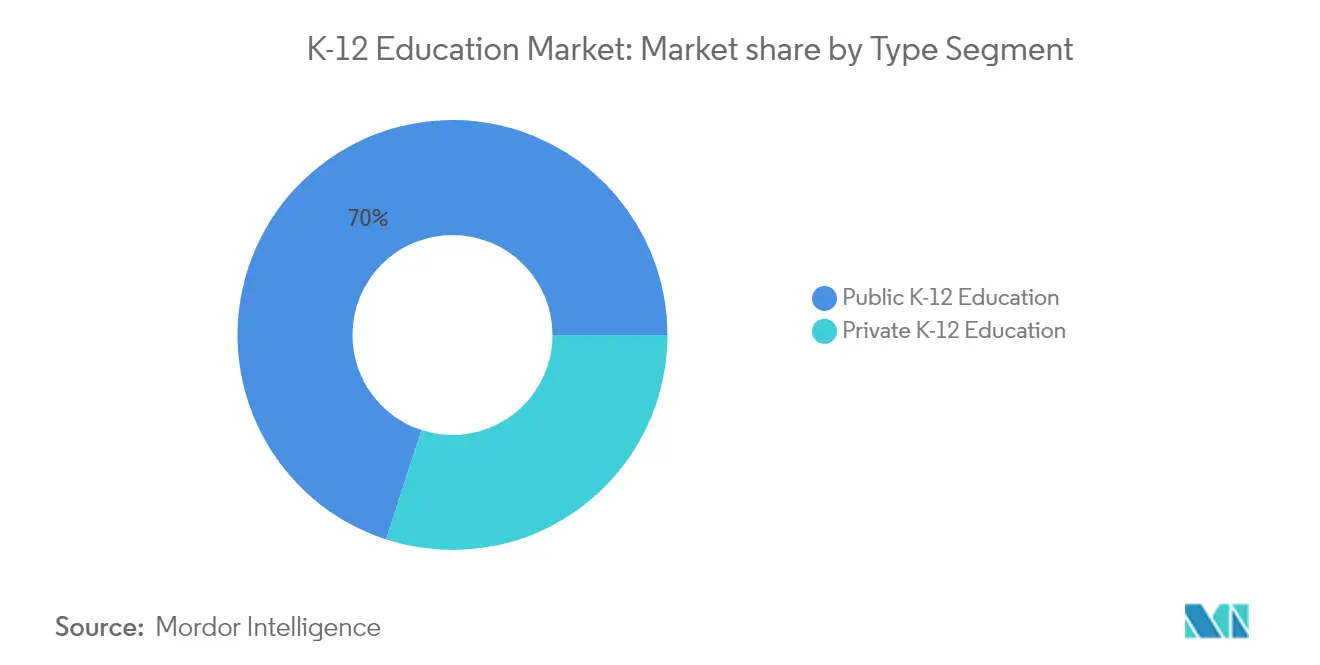
Private K-12 Education Market Analysis
Private K-12 Education is the fastest-growing segment in the K-12 education market, with a forecasted CAGR of approximately 12% from 2024 to 2028. This segment is characterized by its ability to offer specialized curricula, smaller class sizes, and advanced educational technology, which appeal to parents seeking tailored educational services for their children. The growth in private K-12 education is fueled by increasing demand for premium education services and the integration of innovative teaching methods. Trends such as the rise of international schools and the incorporation of e-learning platforms, a key aspect of the Edtech market, are prominent in this segment. Furthermore, private schools often have the flexibility to adopt cutting-edge educational practices, making them attractive to a global audience. The segment's rapid expansion highlights its significant role in diversifying the educational landscape and meeting the evolving needs of students and parents.
K-12 Education Market School Level Segment Analysis
High School K-12 Education Market Analysis
High School is the largest segment in the K-12 education market, accounting for approximately 48% of the global K12 market share. This segment plays a pivotal role in shaping the educational landscape of secondary education, as it prepares students for higher education and career readiness. The dominance of the high school segment is driven by its comprehensive curriculum, which includes advanced subjects and specialized courses tailored to students' future aspirations. The increasing adoption of educational technology in classrooms, such as digital learning platforms and virtual labs, has further enhanced the learning experience in this segment. Additionally, the emphasis on STEM (Science, Technology, Engineering, and Mathematics) education has contributed to its growth and relevance. Recent trends indicate a growing demand for personalized learning and career-oriented programs within high schools, which aligns with the evolving needs of students and parents. As a result, the high school segment continues to lead the market with its substantial market share and influence.
Middle School K-12 Education Market Analysis
Middle School is the fastest-growing segment in the K-12 education market, with a forecasted CAGR of approximately 11% from 2024 to 2028. This segment is crucial as it serves as a transitional phase for students, bridging the gap between primary and high school education. The rapid growth of the middle school segment can be attributed to the increasing focus on holistic development and the integration of innovative teaching methodologies. Schools are adopting interactive and collaborative learning approaches to engage students and enhance their critical thinking skills. The implementation of digital tools and resources, such as e-books and online assessments, has also played a significant role in driving growth in this segment. Furthermore, the emphasis on extracurricular activities and skill development programs has made middle schools more appealing to students and parents. These factors collectively contribute to the robust growth trajectory of the middle school segment in the K-12 education market.
Other School Levels in K-12 Education Market Analysis
The remaining segment, Pre-primary School and Primary School, also holds a significant position in the K-12 education market. This segment focuses on the foundational years of education, emphasizing basic literacy, numeracy, and social skills development. The importance of early childhood education has been increasingly recognized, leading to higher enrollment rates in pre-primary and primary schools. The adoption of play-based and inquiry-based learning methodologies has enhanced the effectiveness of education in this segment. Additionally, the integration of technology, such as educational apps and interactive whiteboards, has improved engagement and learning outcomes for young learners. The segment also benefits from government initiatives and policies aimed at promoting universal access to quality education. Although it is not the largest or fastest-growing segment, the pre-primary and primary school segment remains a vital component of the K-12 education market, laying the groundwork for students' future academic success.
K-12 Education Market Overview
North America K-12 Education Market Analysis
The North American region is projected to account for approximately 25% of the global education market size in K-12 education by 2024. This region plays a pivotal role in the K-12 industry due to its advanced technological infrastructure and the high adoption rate of digital education solutions in schools. Key growth drivers include the increasing emphasis on STEM education, the integration of e-learning platforms, and the rising demand for remote and hybrid learning models. Notable trends include partnerships between educational institutions and technology providers, as well as the growing implementation of learning management system solutions to enhance educational outcomes. Additionally, the focus on continuous learning and accessibility is reshaping the educational landscape in the United States and Canada, further propelling education market growth.
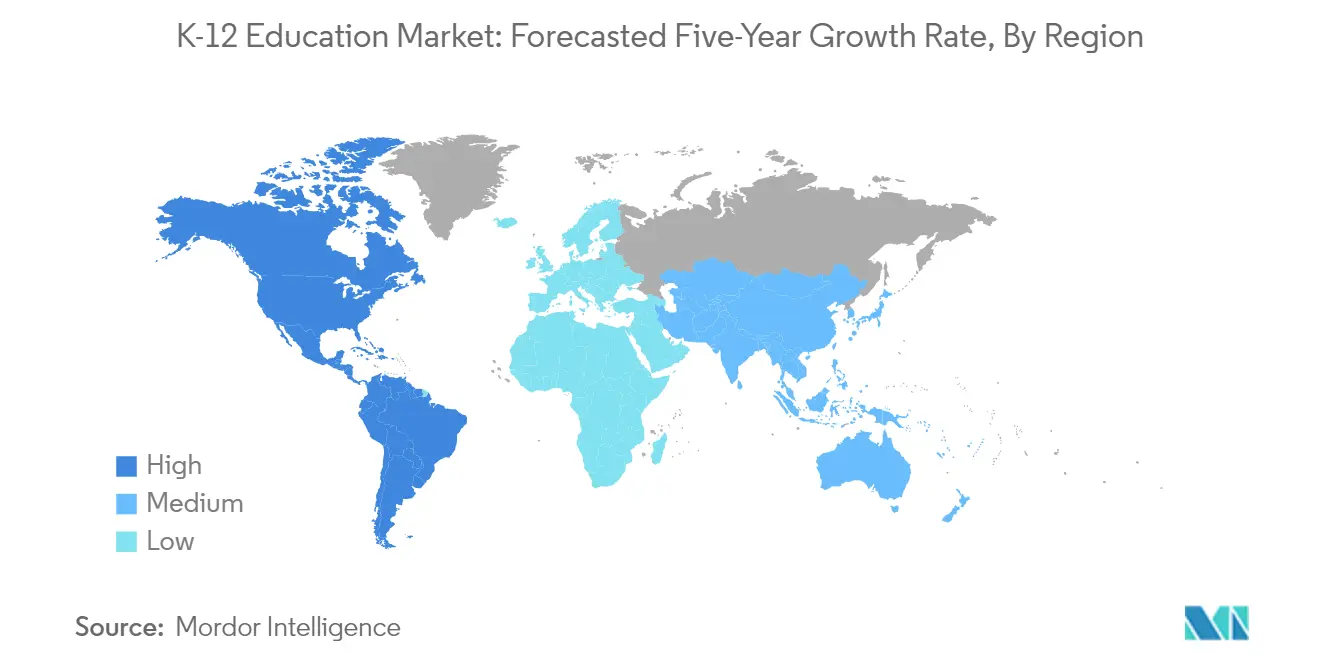
Europe K-12 Education Market Analysis
The Europe K-12 Education Market experienced approximately a 10% CAGR from 2019 to 2024, reflecting robust growth in the education industry size. Europe plays a pivotal role in the Edtech industry due to its strong emphasis on digitalization and integration of advanced learning technologies in public and private schools. Key growth drivers include government initiatives promoting digital education, increased investment in Edtech companies, and the expansion of e-learning platforms across countries like Germany, the UK, and Poland. Notable trends include the adoption of learning management system solutions and e-content, which enhance personalized learning experiences and facilitate teacher-student interaction. Additionally, the region's focus on compulsory education and the digital transformation of public schools significantly contribute to the education market growth.
Asia K-12 Education Market Analysis
The Asia K-12 education market is characterized by its dynamic growth and pivotal role in shaping the education market trends of the region. Key growth drivers include rapid economic development, increasing digitalization, and a strong emphasis on quality education to meet the demands of a competitive global economy. Trends such as the integration of advanced educational technology, the rise of private K-12 institutions, and the adoption of international curricula are reshaping the Edtech market. Additionally, the region's demographic advantage, with a large youth population, further fuels the demand for innovative and accessible educational solutions. These factors collectively position Asia as a critical hub for advancements in K-12 education, fostering a transformative impact on the global education market size.
Australia and New Zealand K-12 Education Market Analysis
The K-12 education market in Australia and New Zealand is characterized by its emphasis on high-quality education systems and the integration of advanced educational technology. These regions are recognized for their robust educational frameworks, which are supported by government initiatives and policies aimed at enhancing digital education and inclusivity. Key growth drivers include the increasing adoption of e-learning platforms, the integration of STEM education market size curricula, and the rising demand for personalized learning experiences. Trends such as the incorporation of artificial intelligence in educational tools and the growing popularity of hybrid learning models represent future trends in K 12 education that are reshaping the market landscape. Additionally, the focus on equipping students with skills for a globalized economy underscores the importance of this market in fostering innovation and competitiveness.
Latin America K-12 Education Market Analysis
The Latin America K-12 education market is characterized by its dynamic growth, driven by increasing investments in digital infrastructure and the adoption of digital education solutions. Countries such as Brazil, Argentina, and Mexico play pivotal roles in this market, leveraging international partnerships to enhance educational access and quality. The region has seen a significant shift towards digital education industry transformation, with initiatives aimed at improving connectivity, providing devices, and developing digital skills among students and teachers. The private K-12 education sector is particularly noteworthy, with substantial investments in Edtech companies that cater to private school institutions. Trends such as the adoption of learning management system solutions and software tools for pre-primary and kindergarten education are gaining traction, reflecting a broader move towards technology integration in classrooms. These developments underscore the region's commitment to modernizing its educational landscape and addressing the evolving needs of its student population, thereby contributing to education market growth.
Middle East and Africa K-12 Education Market Analysis
The Middle East and Africa region plays a pivotal role in the global K 12 size market, characterized by its unique socio-economic dynamics and a growing emphasis on educational development. Key growth drivers include government initiatives to enhance educational access, the increasing adoption of digital education solutions, and a demographic trend of a young and expanding population. Notable trends include the rise of private educational institutions and the integration of advanced technologies such as learning management system solutions and e-learning platforms to address educational challenges. Additionally, partnerships between local and international organizations are fostering innovation and improving the quality of education in the region, reflecting significant Edtech industry trends. These factors collectively underscore the region's potential for sustained growth and transformation in the K-12 sector.
K-12 Education Market Leaders
Top companies in K-12 Education Market
- McGraw-Hill Education (Platinum Equity)
- Pearson Education Inc.
- Cengage Learning India Pvt. Ltd
- Stride Inc. (K12 Inc.)
- Finalsite
- Tata ClassEdge
- Next Education India Pvt. Ltd
- ALMA
- TAL Education Group
- Think and Learn Private Limited (BYJU'S)
- Desmos Studio PBC
- Bettermarks GmbH
- Mooka Media Ltd
- Instructure Inc. (Thoma Bravo)
- Clever Inc. (Kahoot)
The K-12 education market is characterized by significant product innovation and operational agility, with leading Edtech companies focusing on developing advanced digital learning platforms, integrating technologies such as artificial intelligence, augmented reality, and virtual reality to enhance the learning experience. Strategic moves include partnerships with educational institutions and technology companies to expand market reach and improve product offerings. Expansion strategies involve both geographic growth and diversification of product portfolios to cater to various segments within the K-12 sector.
Diverse players in a consolidating market
The K-12 education market is characterized by a mix of global conglomerates and specialized educational technology providers. Major publishing houses like McGraw-Hill and Pearson compete alongside dedicated Edtech companies such as BYJU'S and Stride Inc. The market is experiencing moderate consolidation through mergers and acquisitions, as larger players seek to expand their technological capabilities and market reach. Local players in various countries are also significant, particularly in markets with specific curriculum requirements or language needs, leading to the presence of specialized K-12 curriculum companies.
Market consolidation is driven by the need for comprehensive solutions that can address the full spectrum of K-12 education needs. Acquisitions are often focused on integrating innovative technologies or expanding into new geographic markets. For instance, BYJU's acquisition and subsequent rebranding of WhiteHat Jr demonstrates the trend of larger companies absorbing smaller, specialized providers to enhance their offerings. The market also sees partnerships between technology companies and educational content providers, creating more integrated and robust solutions for schools and students.
Innovation and adaptability drive future success
For incumbents to increase market share and contenders to gain ground, innovation in product offerings and adaptability to changing educational needs are crucial. Success factors include developing AI-driven personalized learning platforms, creating engaging and interactive content, and providing seamless integration with existing school systems. Companies must focus on enhancing user experience for students, teachers, and administrators alike. Addressing the digital divide and providing solutions that work in various infrastructure environments will be key to expanding market reach.
End-user concentration varies by region, with public education systems often representing significant market segments. Companies need to tailor their approaches to both public and private school sectors. The risk of substitution is moderate, as schools may opt for in-house solutions or free alternatives. However, the complexity of educational needs often favors comprehensive, specialized solutions. Potential regulatory impacts, particularly regarding data privacy and curriculum standards, will continue to shape the market. Successful companies will need to stay ahead of regulatory changes and adapt their products accordingly.
K-12 Education Market Leaders
-
McGraw-Hill Education (Platinum Equity)
-
Pearson Education Inc.
-
Cengage Learning India Pvt. Ltd
-
Stride Inc. (K12 Inc.)
-
Finalsite
- *Disclaimer: Major Players sorted in no particular order
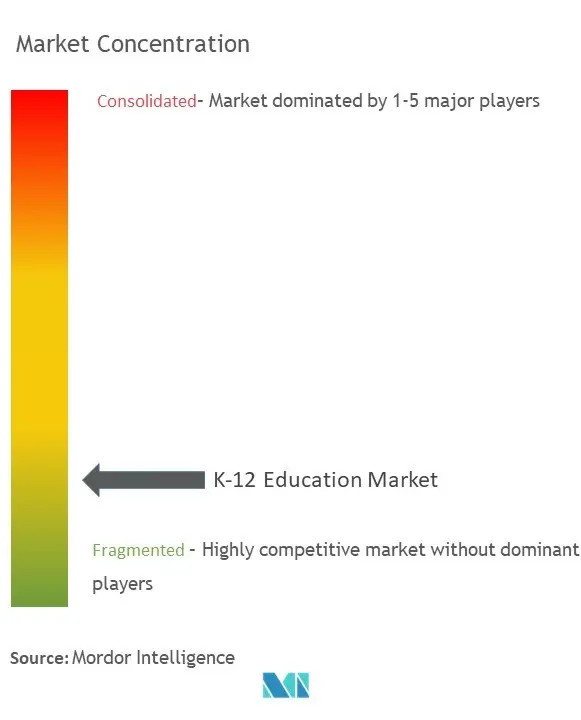
K-12 Education Market News
- July 2024: AudioEye Inc., a digital accessibility company, and Finalsite, a K-12 school community relationship management platform, strengthened their collaboration to boost digital accessibility in K-12 schools. The enhanced partnership, backed by ambitious growth objectives and a thorough go-to-market approach, leverages AudioEye's advanced platform for accessibility testing and remediation. This move comes in response to the Department of Justice's recent rule, under Title II of the Americans with Disabilities Act (ADA), mandating stringent accessibility standards for websites and mobile apps, especially for state and local government bodies, which include public schools.
- June 2024: Unacademy, a prominent edtech startup backed by SoftBank, actively explored a merger with K12 Techno, the entity behind Orchids International Schools. These talks, spanning four weeks, aim to culminate in a joint venture where both parties will hold an equal 50% stake. Unacademy had initially invested in K12 Techno, the parent of Orchids International Schools, three years ago. Also, it is worth mentioning that Peak XV, an investment firm, holds stakes in both Unacademy and K12 Techno. Unacademy attempted to acquire K12 Techno in 2021, but those discussions failed.
- May 2024: Clever, a platform that serves over 100,000 schools, unveiled its latest security offering explicitly tailored for K-12 institutions. This solution focuses on bolstering identity and access management, which is crucial for the unique challenges faced by K-12 schools. Clever's layered security approach is a comprehensive shield, consolidating various protective measures under one reliable provider. Crafted with a focus on K-12 education, these solutions protect students and the entire district community, including teachers and staff. Clever's release comes at a reasonable time. With cyber threats looming over educational institutions, especially those with limited resources, the need for strong defenses has never been more urgent.
K-12 Education Market Report - Table of Contents
1. INTRODUCTION
- 1.1 Study Assumptions and Market Definition
- 1.2 Scope of the Study
2. RESEARCH METHODOLOGY
3. EXECUTIVE SUMMARY
4. MARKET INSIGHTS
- 4.1 Market Overview
-
4.2 Industry Attractiveness - Porter's Five Forces Analysis
- 4.2.1 Bargaining Power of Suppliers
- 4.2.2 Bargaining Power of Buyers
- 4.2.3 Threat of New Entrants
- 4.2.4 Threat of Substitutes
- 4.2.5 Intensity of Competitive Rivalry
- 4.3 Impact of COVID-19 on the Market
5. MARKET DYNAMICS
-
5.1 Market Drivers
- 5.1.1 Growing Popularity of Online Learning
-
5.2 Market Restraints
- 5.2.1 Lack of Infrastructure and Limited Awareness of E-learning
-
5.3 E-book Insights vis-a-vis K-12 Online Education
- 5.3.1 Utility of Digital Content for Classroom Instruction (Digital Content vs. Print Material)
- 5.3.2 K-12 Digital Content Trends and Related Survey Insights
- 5.3.3 Indicative Market Share (%) of E-textbooks in the E-books Industry
6. MARKET SEGMENTATION
-
6.1 By Type
- 6.1.1 Public K-12 Education
- 6.1.2 Private K-12 Education
-
6.2 By Application
- 6.2.1 Pre-primary School and Primary School
- 6.2.2 Middle School
- 6.2.3 High School
-
6.3 By Geography***
- 6.3.1 North America
- 6.3.2 Europe
- 6.3.3 Asia
- 6.3.4 Australia and New Zealand
- 6.3.5 Middle East and Africa
- 6.3.6 Latin America
7. COUNTRY ANALYSIS AND INSIGHTS
-
7.1 United States
- 7.1.1 Market Estimates and Forecasts on K-12 Education, 2022-2029
- 7.1.2 Segment Analysis - United States
- 7.1.2.1 By Type (Public and Private)
- 7.1.2.2 By Technology (E-learning and LMS)
- 7.1.2.3 By Application (Pre-primary and Primary Schools, Middle School, and High School)
-
7.2 United Kingdom
- 7.2.1 Market Estimates and Forecasts on K-12 Education, 2022-2029
- 7.2.2 Segment Analysis - United Kingdom
- 7.2.2.1 By Type (Public and Private)
- 7.2.2.2 By Technology (E-learning and LMS)
- 7.2.2.3 By Application (Pre-primary and Primary Schools, Middle School, and High School)
-
7.3 Germany
- 7.3.1 Market Estimates and Forecasts on K-12 Education, 2022-2029
- 7.3.2 Segment Analysis - Germany
- 7.3.2.1 By Type (Public and Private)
- 7.3.2.2 By Technology (E-learning and LMS)
- 7.3.2.3 By Application (Pre-primary and Primary Schools, Middle School, and High School)
-
7.4 France
- 7.4.1 Market Estimates and Forecasts on K-12 Education, 2022-2029
- 7.4.2 Segment Analysis - France
- 7.4.2.1 By Type (Public and Private)
- 7.4.2.2 By Technology (E-learning and LMS)
- 7.4.2.3 By Application (Pre-primary and Primary Schools, Middle School, and High School)
-
7.5 Japan
- 7.5.1 Market Estimates and Forecasts on K-12 Education, 2022-2029
- 7.5.2 Segment Analysis - Japan
- 7.5.2.1 By Type (Public and Private)
- 7.5.2.2 By Technology (E-learning and LMS)
- 7.5.2.3 By Application (Pre-primary and Primary Schools, Middle School, and High School)
8. COMPETITIVE LANDSCAPE
-
8.1 Company Profiles
- 8.1.1 McGraw-Hill Education (Platinum Equity)
- 8.1.2 Pearson Education Inc.
- 8.1.3 Cengage Learning India Pvt. Ltd
- 8.1.4 Stride Inc. (K12 Inc.)
- 8.1.5 Finalsite
- 8.1.6 Tata ClassEdge
- 8.1.7 Next Education India Pvt. Ltd
- 8.1.8 ALMA
- 8.1.9 TAL Education Group
- 8.1.10 Think and Learn Private Limited (BYJU'S)
- 8.1.11 Desmos Studio PBC
- 8.1.12 Bettermarks GmbH
- 8.1.13 Mooka Media Ltd
- 8.1.14 Instructure Inc. (Thoma Bravo)
- 8.1.15 Clever Inc. (Kahoot)
- *List Not Exhaustive
9. INVESTMENT ANALYSIS
10. FUTURE OF THE MARKET
K-12 Education Market News
K-12, a term used in education and educational technology in the United States, Canada, and some other countries, is a shortened form for the publicly supported school grades before college.
The K-12 education market is segmented by type (public K-12 education and private K-12 education), application (pre-primary school and primary school, middle school, and high school), and geography (North America, Europe, Asia-Pacific, Latin America, and Middle East and Africa). The market sizes and forecasts are provided in terms of value (in USD) for all the above segments.
| By Type | Public K-12 Education |
| Private K-12 Education | |
| By Application | Pre-primary School and Primary School |
| Middle School | |
| High School | |
| By Geography*** | North America |
| Europe | |
| Asia | |
| Australia and New Zealand | |
| Middle East and Africa | |
| Latin America |
K-12 Education Market Research FAQs
What is the current K-12 Education Market size?
The K-12 Education Market is projected to register a CAGR of greater than 6% during the forecast period (2025-2030)
Which is the fastest growing region in K-12 Education Market?
Asia Pacific is estimated to grow at the highest CAGR over the forecast period (2025-2030).
Which region has the biggest share in K-12 Education Market?
In 2025, the Asia Pacific accounts for the largest market share in K-12 Education Market.
What years does this K-12 Education Market cover?
The report covers the K-12 Education Market historical market size for years: 2019, 2020, 2021, 2022, 2023 and 2024. The report also forecasts the K-12 Education Market size for years: 2025, 2026, 2027, 2028, 2029 and 2030.
Our Best Selling Reports
K-12 Education Market Industry Report
The K-12 Education Market is experiencing significant growth, driven by the integration of advanced technologies such as Artificial Intelligence (AI), Augmented Reality (AR)/Virtual Reality (VR), and personalized learning platforms. These innovations are transforming traditional education methods into more interactive and technology-driven models, enhancing student engagement, critical thinking, and mental health support.
Governmental investments are playing a crucial role in improving educational infrastructures, curricula, and teacher training, while also fostering private sector partnerships. This surge in investment presents substantial opportunities for edtech firms, content creators, and educational service providers. The market is characterized by vigorous innovation and mergers as companies strive to meet the evolving educational demands.
Despite the dominance of traditional public and offline education, online learning platforms are gaining traction, offering a personalized and flexible learning experience. The Asia Pacific region is witnessing rapid growth, fueled by increased internet access and government educational reforms. The emphasis on STEM and early education highlights the K-12 sector as a critical investment area.
The market size and market trends indicate a robust expansion, with a detailed market forecast predicting continued market growth. The global market overview reveals that the largest companies are actively participating in this dynamic environment. Comprehensive market analysis and market research provide valuable insights into market share and industry statistics.
Industry reports and industry research underscore the importance of understanding market data and market segmentation. The industry outlook and market predictions suggest a positive trajectory for the K-12 education sector. Market leaders are setting benchmarks, while the market value reflects the sector's economic significance.
For more detailed industry information, including market review and market overview, industry sales, and industry trends, accessing a report pdf from Mordor Intelligence™ Industry Reports can provide further clarity. This report example offers a thorough examination of the market dynamics, making it an essential resource for stakeholders looking to navigate the K-12 education market.




